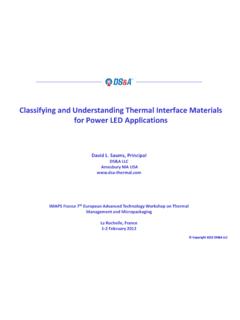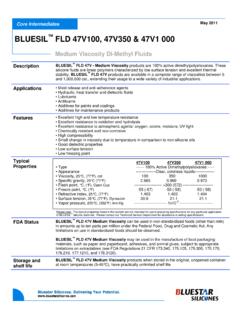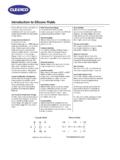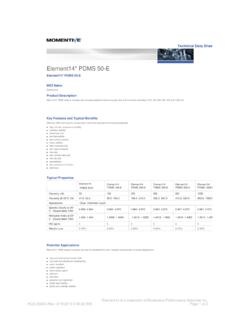Transcription of Electronic Packaging Technologies for Advanced Medical ...
1 Page 1 Electronic Packaging Technologies for Advanced Medical Device Applications IMAPS ATW on Microelectronics, Systems & Packaging for Medical Applications December 5, 2012 Page 2 Electronic Packaging Technologies for Advanced Medical Device Applications Frank D. Egitto, Rabindra N. Das, Glen Thomas and Susan Bagen Endicott Interconnect Technologies , Inc. 1903 Clark Street, Endicott, New York, 13760 Presentation given by: Susan Bagen, PE Page 3 What does this definition tell us? Almost nothing! Probably the most nebulous, diverse market. Unlike other electronics markets (computers, cellphones, entertainment, and even A&D), there is often little or no commonality in technology used even within similar product segments. A Medical device is a product used for Medical purposes in patients, in diagnosis, therapy or surgery. Medical Device Page 4 Medical Electronics/Devices Defibrillators Cochlear Implants Retinal Implants Sensors Optical Non-Implantable Portable Defibrillators Hearing Aids Page 5 Intravascular Ultrasound Catheter Sensor Package Ultrasound X-ray CT Digital Radiography Mammography Pharmaceutical Research Molecular Dynamics Defibrillators Pacemakers Neurostimulators Medical Opportunities Implantable Devices Super-computing Home Healthcare Medical Imaging Page 6 Stretchable Substrates Flexible Substrates Rigid Substrates Implantable Electronics: Substrate Technology Implantable Conformal Electronics Imaging Page 7 Objectives Develop miniaturized rigid substrate for SWaP (size, power and weight) advantage.
2 Develop flexible substrates to satisfy space requirements for Medical imaging and health monitoring devices. Develop bio-compatible and or bio-stable shapeless substrates for Conformal Electronics. Page 8 FDA CE Mark Bio-compatible & Bio-stable: Body fluid solution stability Cytotoxicity Testing Cell growth Implantable Electronics Substrate Coating Over mold Housing Material purity Product Quality Product Traceability Product Reliability Law Requirements Approaches Check Points Page 9 Rigid Substrates Electronics Miniaturization via System-in-Package (SiP) Page 10 Standard Build-up 3-2-3 CoreEZ 2-4-2 Building Blocks SiP Fabrication & Assembly Technology HDI Substrates - Thin core vias are 4x smaller - Thin core requires fewer costly build up layers for the same wiring capacity - Thinner core reduces electrical parasitics (photos are to scale) 2 fully wireable build up layers 2 fully wireable build up layers 3 fully wireable build up layers 3 build up layers only useful for redistribution Page 11 Building Blocks Rigid HDI Substrate With High Core Via Density Very Dense Package Interconnect Ultra Dense Core Via Pitch can eliminate additional build up layers Dual Side Component Mounting Fine Line Width and Spacing 18 25 m HDI Substrate has 9X Core Via Density over conventional build up PWB Standard Build-Up Mechanically drilled core: 400 micron diameter pad, 200 um diameter via UV Laser Drilled CoreEZ Thin Core.
3 100 um diameter pad (50 um via) Page 12 Embedding Resistors and Capacitors (R&C) Remove discrete passive devices and incorporate into the substrate to reduce required surface area Building Blocks SiP Fabrication & Assembly Technology CoreEZ 3-8-3 with Embedded R&C Page 13 Bare Semiconductor Die Building Blocks SiP Fabrication & Assembly Technology Bare Die Unpackaged die has significantly smaller footprint. Flipchip attach results in smallest configuration. PWB Substrate Die Embedded Die Page 14 CoreEZ 2-4-2 substrate SiP assembly (FCA) Si Package Medical Imaging Ultrasound Application Page 15 Miniaturized Rigid Substrate Defibrillators Pacemakers Pulse generators SWaP Reductions Shrink Device Page 16 ICD (Implantable Cardioverter Defibrillator) and Pacemaker Smaller, less intrusive applications for implantable devices High density interconnect substrate 8 layers mm & x mm October 2008 marked 1st human implant with EI substrate.
4 Page 17 3D Packaging Package-Interposer-Package (PIP) Technology Schematic of Package-Interposer-Package (PIP) construction with 4 packages and 3 interposers A new 3D Package Interposer Package (PIP) solution is suitable for combining multiple memory, ASICs, stacked die, stacked packaged die, etc., into a single package. Page 18 3D Packaging Package-Interposer-Package (PIP) Technology Benefits of Package-Interposer-Package High density, small pitch Re-workable and replaceable Polymer or ceramic interposer provides additional support for improving stability and reliability PIP will experience less warpage and thermal stress Mitigates problems with coplanarity between packages Page 19 3D Packaging Package-Interposer-Package (PIP) Technology Package-Interposer Package (PiP) construction with multiple substrates A Top View B- Cross-section Double side assembled substrate with stacked packaged die (memory attached to processor) Page 20 Flexible Substrates Extreme Electronics Miniaturization via Microflex Assemblies Page 21 Microflex Device Packaging Transducers & Die PZT, PLZT, PMN-PT, ASIC Die Substrate Fabrication 25 m laser drilled vias (minimum) 12/12 m line width & space (minimum) IC Assembly Flip chip pitch down to 70 m (minimum)
5 Piezoelectric Crystal assembly Module Tester Full functional module test Page 22 Support of m polyimide film during substrate fabrication: use of rigid frame 14 m line and space Ultra Thin Polyimide Flex Manufacturing Page 23 Micro Pillar Technology for Finer Pitch Applications ASIC die with 70 m bonding pad pitch Page 24 Microflex Assembly Package Extreme Miniaturization Sensor assembly rolled to diameter 5 Flip Chip ASIC,.1mm thick, 31 I/O each, x 22 micron flip chip bumps on 70 micron die pad pitch by mm single layer flex circuit 14 micron wide lines and space copper circuitry micron thick polyimide dielectric Prototype to production Over shipped Single layer HDI Flex 200 m ASIC Die Flip Chip Bumps Page 25 Ultrasound Medical Application 11 m lines / spaces 25 m vias 6 m thick metallurgy m polyimide Flexible soldermask FC ASIC Die & SMT passives High Density Double-Sided Flex Page 26 Multilayer Flex Study to Define Design Rules Flex Flex Bond-ply Thickness thickness thickness Roll Bend/Flex Flex Degree of Flexibility Page 27 12 metal layers, 325 330 m thick, bend radius 25 mm or higher Multilayer Flex Page 28 Multilayer Flex 12 metal layers, 190 m thick, bend radius 25 mm or less Page 29 2 metal layers, ~25 m thick, Roll diameter.
6 Mm 6 metal layers, ~125 m thick Multilayer Flex Page 30 Liquid Crystal Polymer (LCP) LCP based Z-interconnect substrate 4 layer TV, 6 x 6 1, , 2, mil lines & spaces 2 & 4 mil thru vias 1, 2, 3 mil blind vias Understand uVia Reliability 6 Layer 2 mil uvia Page 31 LCP based Rigid-Flex Rigid Flex gives the ability to design circuitry to fit the device, rather than building the device to fit the circuitry. Rigid-flex can stay inside a semi-conformal metal shell Page 32 Roll-to-Roll Manufacturing Supply Roll Take-Up Roll Thin Film Deposition & Laser Processing Photolithography Supply Roll Take-Up Roll Wet Chemical Etching & Cleaning Cooling Drum Laser Azores Photolithography R2R can lead to reductions in cost. A fully integrated facility Lower capital & labor cost Flex Rigid-Flex Rigid Page 33 Stretchable Substrates Conformable Electronics Page 34 Silicones Polydimethylsiloxane (PDMS) SiOCH3CH3nSilicones Nano composites Marine coatings Microfluidics Medicals Electromechanical actuators Microbe-resistant household products Thermal interface materials Random lasers Magnetic Page 35 Stretchable Electronics Conductive wires made from a new carbon nanotube-polymer composite.
7 Professor Takao Someya of the University of Tokyo Stretchable Electronics with a Twist: Prof. John A. Rogers, University of Illinois at Urbana-Champaign) Page 36 Stretchable Electronics Process Development for Metal Adhesion Bio-compatible Bio-stable Fine lines silicone SiOx Metal Page 37 PDMS Coatings Flexible electronics (Assembled substrates) PDMS Coating Filled PDMS Pure transparent PDMS Conformal electronics Page 38 PDMS Coatings Before and after stretching Before stretching Stretched PDMS Stretched PDMS Page 39 Water Soluble PVA Substrate Page 40 Summary Electronics Packaging for Medical Devices demand novel substrate materials, ultra high density assemblies and unique form factors. Widespread practical implementation requires: Implementation of low-cost, high volume manufacturing techniques like roll-to-roll. Biocompatible material sets and supply chain. Thank you for your attention!
















